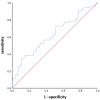A Study of Cardiogenic Stroke Risk in Non-valvular Atrial Fibrillation Patients
- PMID: 33244472
- PMCID: PMC7683797
- DOI: 10.3389/fcvm.2020.604795
A Study of Cardiogenic Stroke Risk in Non-valvular Atrial Fibrillation Patients
Abstract
Objectives: We attempted to develop more precisely quantified risk models for predicting cardiogenic stroke risk in non-valvular atrial fibrillation (NVAF) patients. Methods: We conducted a case-control study, using data from hospitalized patients with AF who underwent transesophageal echocardiography at Shanghai Chest Hospital. A total of 233 high cardiogenic stroke risk patients with left atrial appendage thrombus (LAT) or left atrial spontaneous echo contrast (LA-SEC) and 233 controls matched for age, sex, AF type. Results: AF history, LA diameter enlargement, larger left ventricular end diastolic diameter, lower ejection fraction, greater serum uric acid (SUA), and brain natriuretic peptide (BNP) levels showed association with high stroke risk. The multivariate logistic regression analysis revealed that AF duration, left atrial diameter (LAd), left ventricular ejection fraction (LVEF), SUA, and BNP were independent risk factors of the LAT/LA-SEC. We used LAd, LVEF, SUA, and BNP to construct a combined predictive model for high stroke risk in NVAF patients (the area under ROC curve: 0.784; sensitivity 66.1%; specificity 76.8%; 95% CI 0.744-0.825, P < 0.001). Conclusion: Comprehensive evaluation of LAd, LVEF, SUA, and BNP may help stratify the cardiogenic stroke risk among non-valvular AF patients, guiding anticoagulation therapy.
Keywords: LA-SEC; atrial fibrillation; cardiogenic stroke; left atrial appendage thrombus; risk model.
Copyright © 2020 Song, Xu, Hu, Jiang, Wu, Qin and Liu.
Figures
References
-
- Vahanian A, Alfieri O, Andreotti F, Antunes MJ, Barón-Esquivias G, Baumgartner H, et al. . Guidelines on the management of valvular heart disease (version 2012): the joint task force on the management of valvular heart disease of the European Society of Cardiology (ESC) and the European Association for Cardio-Thoracic Surgery (EACTS). Eur J Cardiothorac Surg. (2012) 42:S1–44. 10.1093/ejcts/ezs455 - DOI - PubMed
LinkOut - more resources
Full Text Sources
Research Materials



